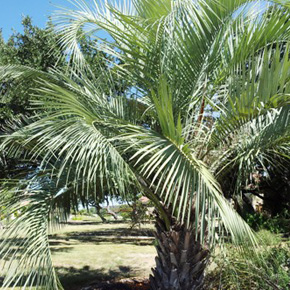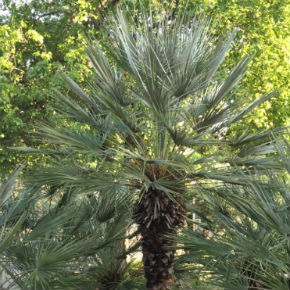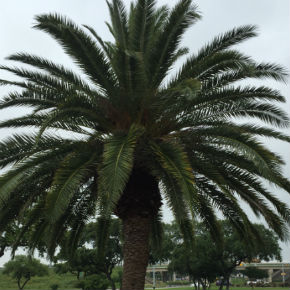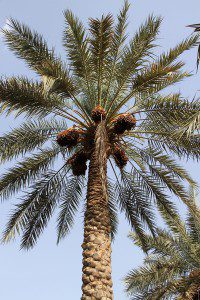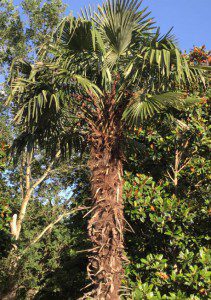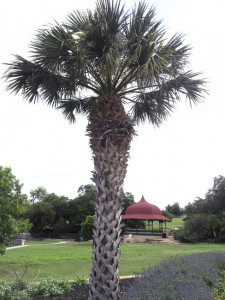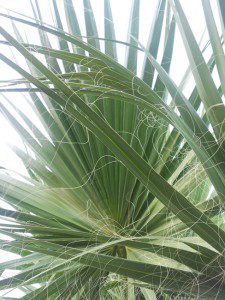Palms provide a great tropical feel to your landscape without excessive maintenance and now is a great time to plant them. See the seven best we suggest sowing.
Warm winds softly blowing. Palm fronds waving gently. Adult beverage in hand. And not a care in the world because the palms I’ve planted don’t require mowing, fertilizer or water and I only have to prune the fronds every three years, if ever. This is low maintenance, low-water landscaping ideal for San Antonio.
Palms provide a great tropical feel to your landscape without excessive maintenance and now is a great time to plant them. While just about all woody plants prefer a November through March planting season, palms, cycads and succulents prefer warm soils and limited rainfall. In other words, just the opposite of woody plants; April to October is palm planting season.
After consulting with a fellow palm enthusiast, we settled on seven favorite palms for the San Antonio area. The main criteria was their durability in the face of cold and drought, and freedom from pests was also a factor.
These are in alphabetical order by scientific name.
Jelly palm – Butia capitata
- Jelly or pindo palm is a moderate sized feather palm noted for its graceful arching blue gray fronds. Unfortunately, it’s also known for decidedly slow growth. This is an excellent palm for the centerpiece of a patio.
- Height: 12-16 feet
- Width: 8-10 feet
Mediterranean fan palm – Chamaerops humilis
- The Mediterranean or European fan palm is one of the cold resistant palms we have. Also, it’s known for its ability to branch at the base, creating a large multi-stem shrub-like plant.
- Height: 6-15 feet
- Width: 6-10 feet
Canary Island date palm – Phoenix canariensis
- Also known as the false date palm, canary island palm is one of the largest palms — feather or fan — for San Antonio. This feather palm’s fronds can grow more than 18 feet long.
- Height: 30-50 feet
- Width: 20-30 feet
Date palm – Phoenix dactylifera
- True date palm can be identified by its long, straight blue-gray fronds. Its trunk tends to be slimmer than the Canary Island palm. Date palms are the least cold tolerant on this list, but there has yet to be a freeze in the last decade like in the 80s, so maybe we can begin to introduce more of these feather palms. Conversely, they are susceptible to lethal yellowing disease (pdf).
- Height: 50-70 feet
- Width: 20-30 feet
Windmill fan palm – Trachycarpus fortunei
- By far, the windmill is the most cold-resistant palm we have in this area. Reputed to have survived five degrees or less for short periods of time, it’s characterized by its “furry” trunk and short fronds. While it does not appreciate our hot summers, it does like late afternoon shade.
- Height: 30-45 feet
- Width: 6-10 feet
Mexican or Texas palmetto – Sabal mexicana
- In my opinion one of the truly beautiful palms for our area. With its long, graceful, blue-green fronds that lack the razor teeth that characterize all the previously mentioned palms, Mexican sabal is worthy of being called “Best in Show.” However, they’re notoriously difficult to transplant and prefer deeper, well-drained soils. In fact, they can be found in the wild along the San Antonio river watershed.
- Height: 40-50 feet
- Width: 10-12 feet
California fan palm – Washingtonia filifera
- Like a true champion, the California fan palm dominates the San Antonio landscape. With more than 100 years of San Antonio living under its belt and several freezes to eliminate the competition, California fan palm can be found from one end of San Antonio to the other. The name filifera comes from the abundance of filaments that emanate from the frond.
- Height: 50-70
- Width: 10-20
Planting Steps
- The best time to plant palms is May and June, but they can be planted from April to mid-October.
- The planting hole does not have to be twice as wide as the root ball that trees require. The hole only needs to be six (6) inches wider than the root ball all the way around.
- Planting at grade — level with the ground — is also not as important as with trees. But keep it as close as possible to the original soil grade.
- Water the original soil into the hole. No prepared planting soil recommended.
- Again, as opposed to trees, stakes are generally recommended. Do not nail the stakes into the trunk, but attach them to a metal or plastic band.
Water
After an establishment period of 6-12 months, water no more than four times a year.
Fertilizer
Fertilize once a year in May with a balanced fertilizer containing micro-nutrients such as iron, manganese and magnesium.
Pruning
Whenever you feel like it needs to be done — this year, next year, 10 years from now or never. However, when you do prune, do so during the coldest months of the year. There may be four, six or eight-legged friends shivering in the fronds and you don’t want to disturb them. Never prune a frond that is not entirely dead. Palms have the ability to transfer nutrients from dying fronds into not-so-healthy ones.
Pests
Pests include the “one that walks upright,” excessive rainfall and a large beetle whose larvae love palm trunks, particularly Washingtonia and Sabal.
Palms can be a source of exotic enjoyment throughout the year. View them as tropical accents to the landscape without the burdens of water, fertilizer or pruning.


